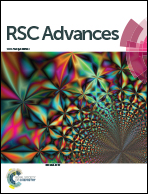Graphene-coated mesoporous Co3O4 fibers as an efficient anode material for Li-ion batteries†
Abstract
Herein, we have designed graphene-coated porous cobalt oxide fibers (Co3O4@G) using coordination polymers as precursors through calcination followed by a subsequent self-assembly process. The graphene-coated porous cobalt oxide fiber nanostructures not only provide good conductivity, but also prevent the aggregation and volume change of the Co3O4 nanoparticles during lithium storage processes. When serving as anode materials in the lithium-ion batteries, the obtained Co3O4@G composites, exhibit remarkable electrochemical performances, including high specific capacity (∼1303.9 mA h g−1 at a current density of 0.2 A g−1), excellent cycling stability (1153 mA h g−1 retention after 80 cycles at a current density of 0.2 A g−1) and high rate capability.


 Please wait while we load your content...
Please wait while we load your content...